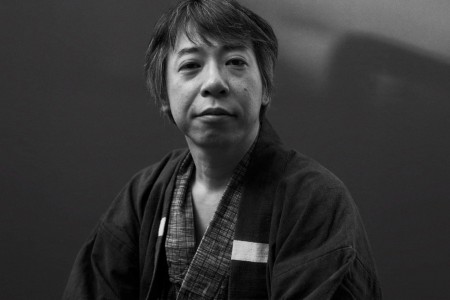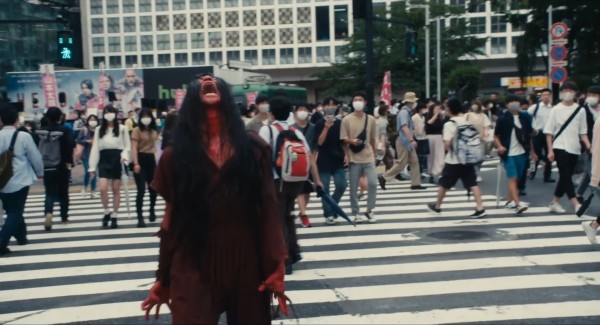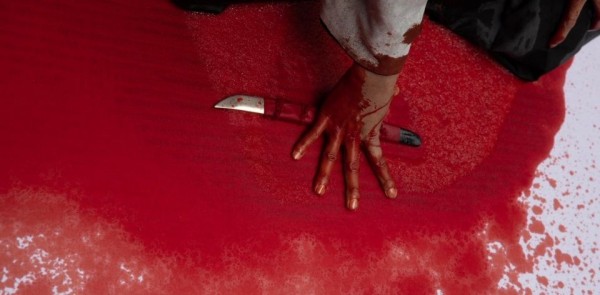THREE SHORT FILMS ('RESURRECTION TRILOGY') BY TOSHIAKI TOYODA: WOLF'S CALLING, DAY OF DESTRUCTION, GO SEPPUKU YOURSELVES - New York Asian Film Festival 2025 TOSHIAKI TOYODA
TOSHIAKI TOYODAToyoda's two arrests, in 2005 for drugs (just before
Hanging Garden was released), and then in 2019 for possession of a firearm (an antique one), both strongly affected him in the rigid world of Japanese culture and led to blacklisting by the local cinema industry, and to his own intense anger. After the 2005 arrest he laid low and did not make another film for four years. The three short and mid-length films included in the 2025 NYAFF,
Wolf's Calling (2019),
Day of Destruction (2020) and
Go Seppuku Yourselves (2021), known as his "Resurrection Trilogy," reveal his anger while having other symbolic meanings - and showing off his mastery as a filmmaker in a particularly pungent way. After I watched
Day of Destruction, with good sound (and the sound is overwhelming and wonderful), I finally started to grok the guy, to see why he has a cult following of people here who collect his Blu-ray sets.
The festival calls these three "passionate metaphorical tomes on society, exile, death, and resurrection." They are also deeply Japanese yet in revolt against what is represented as the rigidity and the simplicity of the culture. They are critiques of it and remarks on his own treatment by Toyoda, But they're also works that revel in the medium.
 WOLF'S CALLING 狼煙が呼ぶ (2019)
WOLF'S CALLING 狼煙が呼ぶ (2019)It has been remarked that Toyoda is great with music, and sound and revels in them. The clanging metallic sounds of the ancient instruments that ring out through much of
Wolf's Calling ( composed by the Edo punk band Seppuku Pistols) echo in the mind for a long time after watching it. The old-sounding Japanese music is deep-penetrating. It speaks to something deep within us that we did not even know was there. (I found and reveled in the sound of Japanese Noh drama when I was no more than around 7 or 8 years old.).
This film refers to the filmmaker's arrest for 'possession of firearms', no doubt. It is an intense, resonant, wonderful recreation of an imagined moment in a flashback, as it were. A contemporary woman, perhaps at a new house, new to her, a handsome, good sized one perhaps on the edge of a forest, goes to the wooden attic, finds a wooden box, unwraps from its cloth an old, worn and discolored pistol.
In the main sequence a man in traditional garb goes by signs of an ancient wolf up a long stairway in a wood to a magnificent old temple or fortress (Mt. Resurrection - Wolf Shrine). Men gather, all in samurai attire, wearing double swords, ready. Several draw their swords. The air is thick with aggression and machismo. Down the hill men in straw hats assemble - farmers, gathered to fight. The farmers, in motley, very motley attire, carry arms, rifles. At the sight of this, the leader of the group from the knightly class up above reaches into his kimono slowly. There is an ominous sound. He draws out the pistol, shiny and new, ready to be used. The ugly modern weapon must be used, though it pushes out the honorable weapoon of bravery and skill, the sword of the samurai. Toyoda is also hinting that Japan's fascistic modern policing system that harrassed him over an antique firearm is ignoble.
After the film comes back to the woman in the attic with the old pistol in her hand and the immense clanging music of antique Japanese percussive instruments of Seppuku Pistols, there are "faux" credits, like the "faux" credits at the end of Ryan Coogler's amazing new film
Sinners with the surprise "envoi" by the Chicago blues great, Buddy Guy. But this time it is a young man in trditional Japanese garb, pacing the heights overlooking the skyline of a great city - Tokyo - looking down, as it were, on the present with a cold eye, nothing more. It may feel a little anticlimactic, but it reasserts the presence of the past over all this expanse of vagueness and light: what is this world?
 THE DAY OF DESTRUCTION 破壊の日(2020)The Day of Destruction
THE DAY OF DESTRUCTION 破壊の日(2020)The Day of Destruction opens with a prelude in black and white. There is a man who comes with permission to enter a closed off tunnel where there is a "monster," the guard jokes, and it has put the all out of work. "Don't you have a mask?" the gatekeeper asks. "Your back will bend," he smiles. WE actually follow him as he walks the entire length of the mine. At the end is a demon. The sparse dialogue wavors between superstition and contemporary event. The punk band lyrics cry out with desperation and irony. Example: "Hey Siri, how much longer must I put up with this? OK Google, which part of this is OK? Would self-restraint for 10 more years be enough?Would self-restraint for 100 more years be enough? If you think you're alive, prove it now."" The walk through this dark looming echoing tunnel is that long look, a minute that seems like an hour, an hour that seems like a minute. It's a strange, extended moment as ominous and barrier-pushing in its way as
Eraserhead. It's understood that the film was initially conceived as a commentary on the 2020 Tokyo Olympics (and no doubt the planned repression to enable them), but was adapted to address the COVID-19 pandemic during its production. The background is that a demon is born in the depths of a mine in a remote, rural village. This is where we are. Villagers have prayed at a local shrine to placate the demon, but he nonetheless finds a vessel in a man whose sister is suffering from a mysterious new disease. He is practitioner of Shugendo, an esoteric branch of Buddhism whose practioners gain supernatural power and save themselves and the masses by conducting religious training while treading through steep mountain ranges. (Here, it's a tunnel.)
But with this background, this 56-minute film is best seen primarily as simply an immersive audiovisual experience. It can be taken as an objection to how COVID was handled by authorities, the use by power of ominous fear of all we don't understand. It can also be seen as an outcry about how corrupt the world is and how need it is in purification.
Day of Destruction harks back to some of the very varied Toyoda's earlier, rawer material and is billed by some a a "horror" film. But it's more a philosophical cry of rage.
 GO SEPPUKU YOURSELVES 全員切腹 (2021)
GO SEPPUKU YOURSELVES 全員切腹 (2021)This one 25 minutes long is set in a part of the samurai era when an epidemic, or plague, is happening. A geisha walks through the village in the opening scene and the camera follows her from behind. When it gets up to her face, there is only an
oni demon mask there. And then she slices her finger off.
Wells are polluted, and scapegoats are sought, though wise men say it can only be an
oni, a demon, that could cause such widespread harm. Local officials seek human scapegoats and an outsider, and a cynical and angry young wandering samurai called Raikan (Yosuke Kubozuka) is chosen as a scapegoat, accused of poisoning the wells, and ordered to commit seppuku. "Go seppuku yourselves" (all commit seppuku) is something he says, near the end of a bold, bitter speech lashing out at the corrupt governors, ending with his committing seppuku, ritually disemboweling himself, and then being beheaded by Toyoda regular Kiyohiko Shibukawa.
It's a stunning performance by Kubozuka, ot only the increasigly intense, theatrical speech, but watching the facial expressions as he moves the knife around in his intenstines, and altogether a memorably bitter, cynical, fearless character: even when he first appears, his first words are, "I am a samurai, I kill people for a for a living"; So he is not just condemning the corrupt officials, but also the samurai code itself under which he has lived for years. Though shorter than the middle film, it may be the most memorable, at least for the character of Raikon. It ends with full-on punk music by the groups utilized differently before, perhaps intentionally to undercut the "period" flavor.
The pent-up rage and creativity exhibited in these three shorter films by Toshiaki Royoda are a joy and, as I said, showed me what was going on when people became cult fans of his work. I have still not been able to watch all his films, but I'll be looking for them.
Wolf Calling, 17 mins.,
Day of Destruction 56 mins.,
Go Seppuku Yourselves 25 mins., released in 2019, 2020, and 2021, where screened for these reviews as part of the New York Asian Film Festival, Jul. 11-27, 2025.





